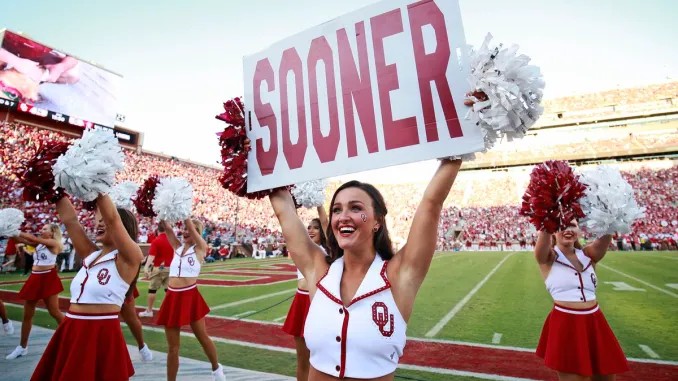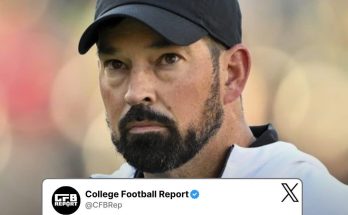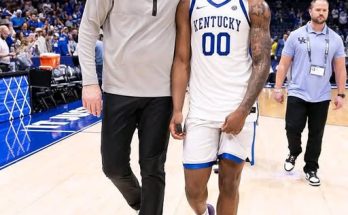In a stunning triumph that has sent waves through the competitive cheerleading world, the Oklahoma Sooners Cheerleaders have etched their names in history as the “World’s Best Cheerleading Squad,” a title officially bestowed by ESPN following a jaw-dropping performance that overwhelmed the reigning powerhouse from Kentucky. What unfolded in front of a capacity crowd of thousands—and millions more watching from home—wasn’t merely a cheer competition; it was a spectacle, a cultural moment, and a redefining of what collegiate cheerleading excellence looks like.
For decades, Kentucky’s cheerleading team has been regarded as the gold standard of the sport. Their dominance at national competitions, particularly those held by UCA and NCA, has been nearly unrivaled, with routines marked by technical perfection, relentless energy, and sharp execution. But on this day, under the brightest lights and on the grandest stage, the Sooners not only matched Kentucky’s energy—they exceeded it. They brought an unmatched combination of power, precision, and personality, and the judges, analysts, and fans alike couldn’t look away.
ESPN, which has long covered the major cheerleading events and recently expanded its digital coverage of performance sports, declared the Oklahoma squad the “World’s Best” following their championship-winning routine. That performance, executed in the final round of the International Collegiate Cheer Showcase in Orlando, Florida, was a masterclass in athleticism and artistry. From flawless pyramids to gravity-defying tosses, synchronized tumbling, and charismatic crowd work, the Sooners delivered a routine that seemed choreographed by destiny itself.
This victory didn’t come out of nowhere. The Oklahoma cheer program has been on an upward trajectory over the past five years, quietly building a reputation for innovation, work ethic, and unity. While other squads relied heavily on legacy and pedigree, the Sooners adopted a hungry underdog mindset that translated into relentless training, meticulous attention to technique, and an openness to pushing creative boundaries. Under the leadership of Coach Taylor Monroe, a former All-American cheerleader herself, the program underwent a transformation that turned potential into power.
Coach Monroe, who took the helm of the program in 2019, brought with her not only years of competitive experience but also a fierce belief in discipline and storytelling. Her routines often revolve around themes and narratives that give each performance a heartbeat, a soul. For the championship performance, Monroe and her team crafted a routine titled “Rise,” symbolizing both their ascent in the cheerleading world and the broader spirit of perseverance that defines collegiate athletes. From the opening moments—when the entire squad emerged in perfect synchronicity to a swelling musical arrangement—spectators knew they were witnessing something rare and unforgettable.
At the center of the performance were team captains Madison Carter and Jordan Fields, whose leadership has been pivotal throughout the season. Carter, a senior flyer known for her poise under pressure and sky-high stunts, was dazzling in the air—rotating through double full twists, needle scales, and transitions that required split-second precision. Fields, a powerhouse base with the strength of a lineman and the finesse of a dancer, anchored the routine with gravity-defying lifts and breathtaking saves. Together, they embodied the squad’s motto: “Built to lift, made to fly.”
What truly separated Oklahoma from the competition, however, wasn’t just the technical brilliance. It was the emotion—the electric current that passed from performer to performer, from cheerleader to crowd. ESPN’s broadcast team noted that every single member of the Oklahoma squad was “dialed in emotionally and physically,” a unity that could be seen in the way they moved as one, cheered as one, celebrated as one. The closing sequence, a high-speed fusion of basket tosses, tumbling passes, and a soaring pyramid that culminated in a standing ovation, was as close to perfect as the sport allows.
The judges agreed. With scores in the high 9s across every category—difficulty, execution, synchronization, and showmanship—Oklahoma achieved the highest overall score in the event’s history. It was an undeniable coronation, one that not only dethroned the traditional giants of the sport but also marked a paradigm shift in collegiate cheerleading. No longer could Oklahoma be seen as merely a rising program. They were now the bar.
Social media erupted in the wake of the victory. Within hours, clips of the routine had gone viral, earning millions of views on TikTok, Instagram, and YouTube. Prominent former cheerleaders, athletes, and even celebrities took to Twitter to congratulate the squad. NFL players praised the athleticism. Olympic gymnasts nodded in respect. ESPN’s official account called it “the most complete and awe-inspiring cheer performance we’ve ever seen.” Soon after, the network’s editorial board made the unprecedented move to name them the “World’s Best Cheerleading Squad,” citing not only the victory but the movement they had created.
For the squad members themselves, the emotions were overwhelming. Many wept as they took the podium, championship rings gleaming, arms linked in solidarity. “We worked for this every single day,” said Carter in a post-performance interview. “It’s not just about the trophies. It’s about proving that passion, discipline, and love for what you do can take you all the way. We came here to change the game, and we did.”
The victory has already begun to reshape the cheerleading landscape. Recruits who once had their sights set on legacy programs are now seriously considering Oklahoma as the place to be. The university itself has embraced the moment, with athletic director Joe Castiglione praising the cheerleaders’ commitment and labeling them “as elite as any national championship team we’ve had.” Plans are underway for a celebratory parade in Norman, and the squad has been invited to perform at multiple high-profile sporting events, including a halftime show during the College Football Playoff.
Perhaps what makes this story even more remarkable is how the Oklahoma cheerleaders have carried themselves in victory. Despite unseating a dynasty, they’ve shown nothing but class and admiration for their competitors. “Kentucky has been an inspiration for so many of us,” said Fields. “They’ve set the standard for years, and we’re grateful for what they’ve done for the sport. To compete with them, let alone win, is an honor.”
In the days following the win, Coach Monroe emphasized that while the accolades are wonderful, the real legacy lies in what this victory represents. “It’s about showing young athletes everywhere—especially young women—that with vision, heart, and relentless effort, you can be the best in the world at what you love. That’s the message we’re most proud of.”
And that message is resonating far beyond the world of cheerleading. Schools, parents, and student-athletes are seeing the Sooners not just as a successful cheer squad but as a blueprint for building something extraordinary from the ground up. In a time when collegiate sports are increasingly professionalized and performance pressure mounts, the Oklahoma cheerleaders have brought the focus back to passion and pride. They’ve turned a sport often underappreciated into a centerpiece of national admiration.



